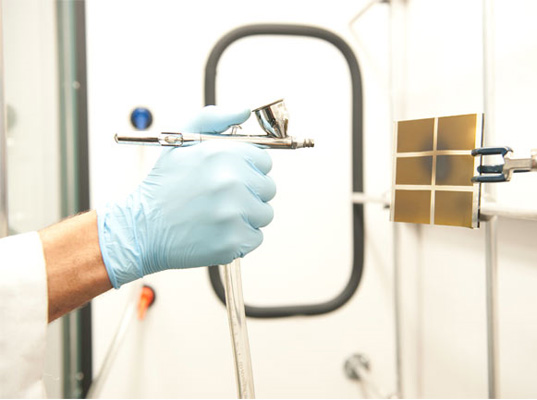A recent article on GreenBiz.com states that solar cells could soon be produced more cheaply by using nanoparticle “inks” that can be spray painted onto buildings, rooftops, and windows to absorb electricity-producing sunlight:
Cheaper, Spray-On Solar Panels Could Appear in Three Years (by GreenBiz Staff; published August 24, 2009):
“Researchers at the University of Texas have developed a method to create photovoltaic panels at one-tenth the cost of existing technologies using nanoparticle “inks” to generate electricity from the sun. The group, lead by Brian Korgel in the University’s chemical engineering department, predicts that the technology, which would allow solar panels to be painted on rooftops or the sides of buildings, could be market-ready in three to five years. “The sun provides a nearly unlimited energy resource,” Korgel said in a statement, “but existing solar energy harvesting technologies are prohibitively expensive and cannot compete with fossil fuels.”
The technology has been in development for the past two years, with Korgel collaborating with professors Al Bard and Paul Barbara, both of the University of Texas’s Department of Chemistry and Biochemistry, and Professor Ananth Dodabalapur of the Electrical and Computer Engineering Department. The team last year published a proof of concept paper in the Journal of the American Chemical Society.
When the technology has been improved, the panels could consist of inks painted on plastic or stainless steel, or directly onto buildings themselves. While the technology has yet to reach efficiency levels of existing solar technologies — currently the spray-on panels are just 1 percent efficient, while existing panels can reach 25 percent efficiency or more — using the nanoparticles can potentially boost efficiency because of the tiny size of the materials. “If we get to 10 percent, then there’s real potential for commercialization,” Korgel said. “If it works, I think you could see it being used in three to five years.” Korgel added that other future uses for the technology could include a semi-transparent layer that would allow windows to double as solar cells.”
Editor’s note: The research, which was published in a recent issue of the Journal of the American Chemical Society, was funded by the National Science Foundation, the Welch Foundation, and the Air Force Research Laboratory.




